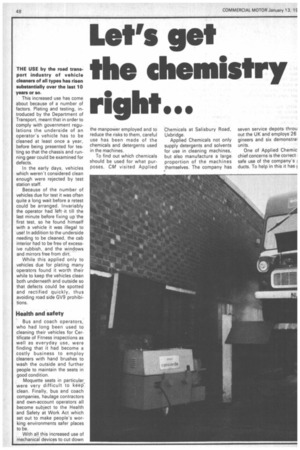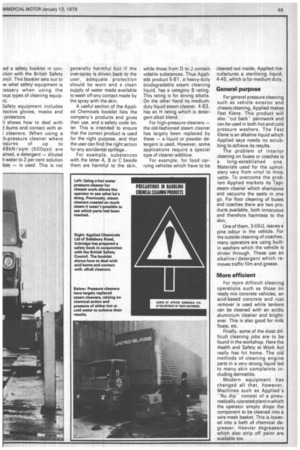Let's get the chemistry right...
Page 50

Page 51

If you've noticed an error in this article please click here to report it so we can fix it.
THE USE by the road transport industry of vehicle cleaners of all types has risen substantially over the last 10 years or so_ This increased use has come about because of a number of factors. Plating and testing, introduced by the Department of Transport, meant that in order to comply with government regulations the underside of an operator's vehicle has to be cleaned at least once a year, before being presented for testing so that the chassis and running gear could be examined for defects.
In the early days, vehicles which weren't considered clean enough were rejected by test station staff.
Because of the number of vehicles due for test it was often quite a long wait before a retest could be arranged. Invariably the operator had left it till the last minute before fixing up the first test, so he found himself with a vehicle it was illegal to use! In addition to the underside needing to be cleaned, the cab interior had to be free of excessive rubbish, and the windows and mirrors free from dirt.
While this applied only to vehicles due for plating many operators found it worth their while to keep the vehicles clean both underneath and outside so that defects cOuld be spotted and rectified quickly, thus avoiding road side GV9 prohibitions.
Health and safety
Bus and coach operators, who had long been used to cleaning their vehicles for Certificate of Fitness inspections as well as everyday use, were finding that it had become a costly business to employ cleaners with hand brushes to wash the outside and further people to maintain the seats in good condition.
Moquette seats in particular_ were very difficult to keep clean. Finally, bus and coach companies, haulage contractors and own-account operators all become subject to the Health and Safety at Work Act which set out to make people's working environments safer places to be.
With all this increased use of mechanical devices to cut down the manpower employed and to reduce the risks to them, careful use has been made of the chemicals and detergents used in the machines.
To find out which chemicals should be used for what purposes, CM visited Applied
Chemicals at Salisbury Road, Uxbridge.
Applied Chemicals not only supply detergents and solvents for use in cleaning machines, but also manufacture a large proportion of the machines themselves. The company has seven service depots throu out the UK and employs 26 gineers and six demonstral units.
One of Applied Chemic chief concerns is the correct safe use of the company's I ducts. To help in this it has I
:ed a safety booklet in conction with the British Safety mcil. This booklet sets out to ,w what safety equipment is ;essary when using the ious types of cleaning equipnt:
Safety equipment includes tective gloves, masks and protectors.
It shows how to deal with J burns and contact with ali cleaners. When using a h-pressure cleaner where issures of up to 48kN /sqm (500psi) are ained, a detergent — diluted h water to 2 per cent solution less — is used. This is not generally harmful but if the over-spray is driven back to the user, adequate protection should be worn and a clean supply of water made available to wash off any contact made by the spray with the skin.
A useful section of the Applied Chemicals booklet lists the company's products and gives their use, and a safety code letter. This is intended to ensure that the correct product is used for the right purpose, and that the user can find the right action for any accidental spillage..
For example, substances with the letter A, B or C beside them are harmful to the skin, while those from D to J contain volatile substances. Thus Applieds product 5-61, a heavy-duty biodegradable steam cleaning liquid, has a category B rating. This rating is for strong alkalis. On the other hand its mediumduty liquid steam cleaner, 4-83, has an H rating which is detergent alkali blend.
For high-pressure cleaners — the old-fashioned steam cleaner has largely been replaced by these — a liquid or powder detergent is used. However, some applications require a special type of cleaner additive.
For example, for food carrying vehicles which have to be 'cleaned out inside, Applied manufactures a sterilising liquid, 4-45, which is for medium duty.
General purpose
For general pressure cleaning such as vehicle exterior and chassis cleaning, Applied makes Fast Klene. This product will also "cut back" paintwork and can be used in both hot and cold pressure washers. The Fast Klene is an alkaline liquid which Applied says needs no scrubbing to achieve its results.
The problem of interior cleaning on buses or coaches is a long-established one. Materials used for the upholstery vary from vinyl to moquette. To overcome the problem Applied markets its Tapisteam cleaner which shampoos and vacuums the seats in one go. For floor cleaning of buses and coaches there are two products available, both innocuous and therefore harmless to the skin.
One of them, 3-05D, leaves a pine odour in the vehicle. For the outside cleaning of coaches, many operators are using builtin washers which the vehicle is driVen through. These use an alkaline/detergent which removes traffic film and grease.
More efficient
For more difficult cleaning operations such as those on ready mix concrete vehicles, an acid-based concrete and rust remover is used while tankers can be cleaned with an acidic aluminium cleaner and brightener. This is also good for milk floats, etc.
Finally, some of the most difficult cleaning jobs are to be found in the workshop. Here the Health and Safety at Work Act really has hit home. The old methods of cleaning engine parts in a very strong liquid led to many skin complaints including dermatitis.
Modern equipment has changed all that, however. Machines such as Applied's "Nu dip" consist of a pneumatically operated plantin which the operator simply drops the component to be cleaned into a wire mesh basket. This is lowered into a bath of chemical degreaser. Heavier degreasers which also strip off paint are available too.




























































































